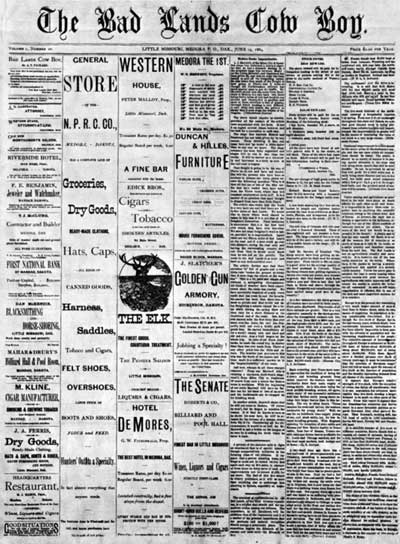|
Theodore Roosevelt and the Dakota Badlands |
 |

Front page of "The Bad Lands Cow Boy."
Courtesy State Historical Society, North Dakota.
Lawlessness in the Little Missouri Region
Like many frontier communities, Billings County, in which both Medora and Little Missouri were located, was slow to organize its government. It early needed an effective local government to enforce law and order. The county at this time was attached to Stark County for administrative purposes and it was necessary to take violators to Dickinson, some 40 miles distant, to try them in the county courts. This difficulty no doubt contributed to the lawlessness which flourished in both Little Missouri and Medora. In January 1884 the Glendive (Mont.) Times commented on the situation:
Little Missouri is fast gaining a very unenviable reputation. It seems as though what little law does exist in the place cannot be enforced, and the better class of citizens being in the minority a committee of safety is out of the question . . .
Several months later an effort was made to organize Billings County. The Dickinson Press gave the movement its editorial support, commenting:
Medora is clamoring for a county organization. We hope they will get it. If there is any place along the line that needs a criminal court and jail it is Medora. Four-fifths of the business before our justice of peace comes from Billings County.
For some time rustlers had been active in eastern Montana and along the Little Missouri. During the autumn and winter of 1883-84, theft, or rustling, of horses and cattle increased. The rustlers' hideouts were hand to find and, once found, their cabins were miniature fortresses. In the spring of 1884 several individuals took the matter before the regular meeting of the Montana Stockgrowers Association in Miles City. The stockmen decided that the association itself should take no action. As a consequence, the rustlers became bolder. In July The Bad Lands Cow Boy summarized the situation:
From all parts of Dakota and Montana came reports of depredations of horse-thieves. . . . Several men have been hung for horse-stealing, but the plague still goes on. We wish to be placed on record as believing that the only way to cure horse-stealing is to hang the thief whenever caught. . . .
To combat the rustlers, several prominent Montana cattlemen during the summer of 1884 banded together as vigilantes. They raided eastern Montana in the late summer, and during early autumn they invaded the Little Missouri region. They hanged a number of suspicious characters, and in some instances intimidated innocent men. While their methods may be deplored, they did discourage horse and cattle stealing. The Cow Boy in the following year reluctantly admitted, "the result of their work has been very wholesome" as "not a definite case of horse stealing from a cowman has been reported since." In all probability Roosevelt, as a newcomer to the region, had no part in the activities of the vigilantes. It is unlikely that he would have been invited to join an organization which depended upon secrecy for success in administering its self-appointed horse law enforcement.

|

|
|
Last Modified: Sat, Jan 17 2004 10:00:00 am PDT |


